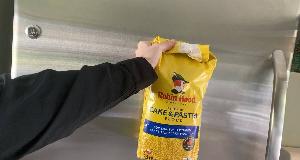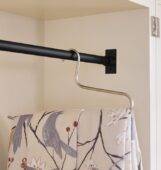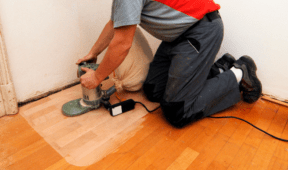How to Hem Dress Pants: A DIY Guide for Hemming Men’s Dress and Suit Pants

There are two basic principles to the ManMade approach to style and dress: fit is everything, and buy high-quality, universal items that will last. In order to help you hold on to those investment items, and make sure they suit you as best they can, ManMade is happy to present our latest series: The DIY Tailor. This summer and fall, professional tailor and alteration specialist Danni Trester will teach us some basic sewing principles and easy DIY repairs that every guy should know.
One of the simplest things you can do to look a little more dapper is by hemming your dress pants when they’re too long. As someone who does this for a living, it’s the first thing I notice about people, especially in a professional setting. You can always tell when pants are too long, either they’re dragging on the floor, or the break (the fabric that pools on top of the foot on the pant front) is too big. Here’s a photo guide to making those pants look sharp. You might need a sewing machine, but this is likely a project that can be accomplished with just a needle and thread.
1) Gather your supplies. Depending on the method you choose, you’ll need a needle, matching thread, scissors, tailor’s chalk (as discussed in last week’s demo), ruler, iron/board, and possibly a sewing machine that has a zig-zag stitch.

2) Follow steps 2-6 from the jean hem lesson to mark up your pants. Once you have the marks, lay the legs together on the table so the chalk marks are together.

3) Like the jean hems, run your chalk along the edge of the rule to mark and line across the pant legs. Flip over the top leg to mark the inseams, and then the bottom leg to mark the back of the bottom leg.
In the jean demo, we marked for a 1/2″ hem. In dress pants, the typical hem depth (the amount turned under) is a 1 1/2″. Measure this on the top leg and mark your lines.


4) There are a couple of ways to sew up your hems. One way requires a serger (the stitching on the insides of clothing that secures raw edges), or a zig-zag stitch. If you don’t have any sewing machines, you can secure the cut ends of the fabric by rolling it over, sort of like a large rolled hem. If you’d like to do the rolled way, you’ll need to mark an extra 1/2″ on your pants so that it can be pressed and turned under, leaving a clean edge to sew.

Extra 1/2″ marked for a rolled edge:

5) Once you’ve marked the proper lines, cut off the excess. If you’re doing a serged/zigzagged edge, you should have this:

If you want to do the rolled version, your legs should look like this:

6) Now you need to prepare your edges for sewing. If you’re rolling, you’ll need to press that extra 1/2″ so it lays flat as you’re trying to sew it. Roll the raw edge to the inside of the pant along your chalk line. 
7) Press along this line all the way around both legs. Be careful not to go too far up the leg as you don’t want to press out the line you marked at 1 1/2″ where the hem will be. If you do accidentally press the hem line out (waxy tailor’s chalk can easily do that, the chalky kind won’t), you can go back once you’re done pressing and mark your line back on.


8) If you’re zigzagging, set up your machine with matching thread. Use your scraps to get the stitch length and width right. You want a zig zag that’s about a 1/4″ wide, and a little less than 1/8″ in between the stitches. If you get it too big, the stitching won’t do it’s job, which is to encase the raw edges. If you do it too small, you’ll end up stretching the fabric which will just make more difficult when you’re sewing up your hem.

Sew all the way around both legs, overlapping the stitching when you get back to where you started. Once you’re done, lightly press the fabric to flatten out any stretching that may have happened. (Careful not to press out your hem line!)

9) Now that your edges are prepared, you’re ready to sew up your hem! At this point, the process is the same for both the zigzag edge, and the rolled edge. For ease of demonstration, I’m using the rolled method so it’s easier to see the handsewing.
Cut a piece of thread that’s double the length to go around one leg. Thread your needle and tie the cut ends together so that you’re sewing with two strands (like in the button lesson).

10) Start at the inseam and fold up the leg to the chalked hem line.

11) Insert your needle into the seam allowance of the inside leg to start your thread.

Pull through:

12) Insert the needle in the back of the rolled edge and bring the needle out about 1/8″ from the edge.

Pull through:

13) On the left of the rolled edge, pick up only a few threads of the fabric and slide your needle through. It’s really important to only pick up a few threads. As you start sewing along, if you get too many threads on the needle, you’ll see your handsewing stitches on the outside of the pants. It may seem like a couple of strands won’t be strong enough, but it’s plenty strong.

14) About 3/8″ to 1/2″ up from where you pulled the thread through, insert the needle in the back of the rolled edge and pull the needle out the front.

Pull through:

15) Again, to the left side of the rolled edge, pick up only a few threads with the tip of your needle, and pull through.

A closer look:

And again, about 3/8″ to 1/2″ up from your last stitch, insert the needle into the back of the rolled edge and pull through the front.

At this point, you’ll be repeating steps 13 and 14. Once you’ve got a few stitches in, flip over the leg so you can see the outside.
When you pick up threads to make a stitch, this is how much needle you should see on the outside of the pants. You can use this as a gauge so you know you don’t have too many threads on the needle (it’s just a speck of silver):

It’s also important to keep consistent spacing in between your stitches. Although you don’t see the thread from the outside, you will see a slight impression. If you have varying stitch lengths, it won’t look as nice as evenly spaced ones.
16) If your stitches are looking good, keep on going!

17) After you’ve gone a fair amount, your hem should look something like this:

The outside will look something like this:

Can’t see the stitches? Good! You shouldn’t be able to.
Don’t worry if you feel like this is taking a while. Hand sewing is time-consuming. Professionals use a hamming machine that can do this sort of stitching in a matter of seconds. But don’t be discouraged by how long it may take. Put on some Netflix and settle in!
18) Once you get back to where you started, tack a couple of times where your first stitch is.

Snip the thread, leaving enough to tie a knot.

Tie a knot, and clip the extra thread.

Now do the other leg and you’ll be ready to press!
19) Just like in the jean demo, start pressing on the inside of the leg. Go around the whole leg and use steam to set the hem and flatten out the fabric/stitches.

Now press the outside lightly to flatten the stitch impressions and re-crease the pants if they have creases on the front and back.

Alright! You did it!

Danni Trester is a tailor with over 11 years experience. She is currently located in Rochester, MN. In addition to alterations, she is a designer and shoemaker.









